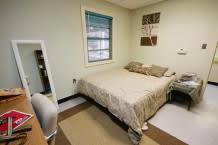The life of a shelter dog is stressful. Ask anyone involved with animal sheltering and they will undoubtedly agree. No matter how nice the facilities, how tasty the food, how plentiful the treats and enrichment, or how frequent the walks, animal shelters are still loud, overwhelming, and unnatural environments in which to live.

“Grandpa’s Study”
Thankfully, there are shelter protocols that allow opportunities for volunteers and staff to help out. Some of the richest experiences a shelter dog can receive are field trips to a park, a relaxing lunch on a patio, an adventure in an animal-friendly business, or a sleepover in someone’s home. Getting a dog into a new environment often allows the handler to observe the dog in a more natural setting and can often increase a dog’s willingness to engage in training and play. It allows for more accurate observations about a dog’s personality. And when someone is able to take a dog home for an overnight, it always helps the handler gather vital information about the dog’s in-home behavior (including whether or not the dog is house-trained, good with boundaries, comfortable with being in a home, etc.) which can then be shared with the shelter to influence the dog’s adoptability. In all cases, the change of scenery, smells, routine, and reduction in auditory stimuli are immensely beneficial to the mental and physical health of a shelter dog.

“The Bedroom”
Unfortunately, for any number of reasons, most staff and volunteers are limited in the amount of time they can spend with individual dogs and overnights are often not options for those who already have other animals at home. The actual number of people who can provide these kinds of breaks, on a regular basis, is quite low. Does this mean that the majority of shelter pups won’t reap the benefits of the aforementioned outings? Not necessarily. There is another option and it is called a “real life room.”

“Grandma’s Room”
Real life rooms are spaces that are set up on a shelter’s grounds and simulate rooms that one finds in a home. The spaces are furnished with common, everyday items which are appropriate for the theme of the room and are available for staff, volunteers, and potential adopters to use during shelter hours. Similar rooms have been in operation by Best Friends Animal Sanctuary for years and are recommended by the Center for Shelter Dogs. Years ago, the directors of Dogs Out Loud had a vision to set up some rooms for another organization and after a lot of elbow grease, a bunch of dedicated volunteers, and some long weekends, the results were wonderful. We ended up with four distinct real life rooms:
“Grandpa’s Study” was furnished with a wing-back chair with a throw pillow, a large rug, a coffee table, a low bookshelf, a CD/radio, a TV/DVD combo, a floor lamp, a child’s scooter, various plants, assorted magazines, several books, a dog bed, and a wire crate.
“The Bedroom” contained a fully made bed, artwork, a full-length mirror, a desk with a television, an end table with books, an alarm clock/radio, a floor rug, house slippers, assorted chachkies, and window blinds.

“The Kitchen”
“Grandma’s Room” was decked out with a tall bookshelf full of books and chachkies, a coat rack with coats and hats, a vacuum cleaner, a very large floor rug, a sofa with throw pillows, a full-length mirror, a TV and DVD player, a clock radio, more artwork, a wire crate, and a dog bed.
“The Kitchen” was complete with a refrigerator, a microwave, a sink, a blender, a set and decorated table, a broom and dustpan, a mop, dishes and glasses, a trash can, window curtains, and real food.
Real Life Rooms Have an Impact
What we discovered, in very short order, was that these rooms ended up functioning for several different purposes:
1) They did indeed give shelter dogs a quiet, relaxing space in which to share cuddles with a human and catch up on some much-needed rest.

Banjo catches up on much-needed sleep in “The Bedroom”

Champ having some downtime while his volunteer cleans “The Kitchen”
2) They provided a distinct area within the shelter where stressed, bored, and frustrated dogs could work on enrichment items to alleviate pent-up energy and provide healthy stimulation away from the hustle and bustle of the kennels.

Oliver practices nose work in “Grandpa’s Study”

Leroy works a food puzzle in “Grandpa’s Study”
3) They allowed potential adopters to accompany a staff member or volunteer into a real-life room with a dog to spend time with him/her, get to know the dog outside of the kennel, and determine whether or not the dog was a good fit for them.
4) They served as a distraction-free area in which staff and volunteers could take a dog and work on training skills, handler focus, and acclimation to household items (which are sometimes foreign and scary to shelter pups).

Tiffany practicing calm behavior and learning manners in “Grandpa’s Study”
What began as a “what if” grew into a surprisingly efficient project with amazing results. The response was overwhelmingly positive and it became apparent that the investment was very much worth it. By having space that seemed like a whole other location, but was actually steps from their temporary homes, dogs were able to have access to these rooms for a variety of beneficial purposes and on a much more regular basis.
Getting Started
Want to know how you can create real life rooms at your shelter? We broke the process into general steps, and added some helpful tips, to get you started:
1) Identify or acquire a space for the real life room(s). This could be an unused office/room within the shelter or a climate controlled outbuilding, tiny house, or trailer. The space must have a door that can be closed to allow the dog to roam freely within the area.
Tip: For safety, create double-sided signs that can be flipped to occupied/in-use or available/not-in-use so that everyone knows when a room is available.
2) Determine how the space(s) will be used and what items are needed. Decide what kind of theme your real life room(s) will have and, based on that, what items you will need in order to furnish the space(s). Think about common and foundational items you have in your own home, including paint, floor coverings, furniture, decor, appliances, novelty items, etc. Don’t forget to include lots of paper towels, cleaning supplies, pet odor neutralizer, and crates and dog beds (for training). Make a list of these items and distribute them to volunteers, donors, and shelter management and ask for help acquiring them.
Tip: Use sites like Craigslist and NextDoor to find household items that people are giving away for free. While the items will not be new, you would be surprised at the quality of items people will let go if someone will just come pick it up. Also, don’t be afraid to contact sellers of low-priced items to see if they would actually be willing to donate to your project. Often, they will.
3) Inventory, conceptualize, and organize. Once you have collected all your requested items and have everything together, divide items up by the themed space(s) in ways that seem appropriate. For example, group all kitchen items together or combine living room furnishings into one room.
Tip: By doing this step prior to choosing paint, you can have an idea of what color might help tie the room together.
4) Create a schedule and plan out workdays that make efficient use of human-power. Depending on how many rooms you will create, the current condition of those rooms, and the number of volunteers you have, break out the project into clearing out/cleaning/prepping the spaces, painting the areas, and assembling the rooms.
Tip: Taking a poll of when volunteers are free and scheduling accordingly, or making project leads available on various days and times, will broaden your resource pool. Also, providing food and beverages during the actual workdays will encourage volunteers to stay longer.
5) Create, print, and publish rules for the real life rooms. In partnership with shelter management, determine what the rules of the real life rooms will be, document them, print them out, and make them known. You can use bulletin boards in the rooms to post them, or provide training to shelter volunteers prior to use.
Tip: Consider rules such as handlers cleaning up after themselves and their dogs, collective responsibility for ongoing maintenance (i.e. vacuuming, dusting, removing trash, etc.), only one dog per room, knocking before entering, allowing potential adopters priority access, and so on.
6) Plan a grand opening celebration! When your hard work is done, make sure you celebrate the job you’ve completed! Be sure you thank your supporters, educate your volunteer base, and publicize the spaces to your community. It will help ensure your hard work doesn’t go to waste and may draw in new shelter supporters who are interested in innovative ideas.
Tip: Call your local media stations and ask if they would send someone to cover your opening.
7) Use the rooms. Use the rooms. Use the rooms. These rooms help homeless dogs relax and learn how to be appropriate companion animals. They promote adoptability. They strengthen volunteer support. They encourage adoptions. They save lives.
Make Real Life Rooms a Reality at Austin Animal Center
At the resounding approval of shelter management, we are making plans to create real life rooms at Austin’s city shelter. Amplify Austin Day will kick off our campaign to raise at least $15,000 of the $30,000 we need for 2 or 3 trailers, mobile homes, tiny houses, or similar type of buildings to use as real life rooms on shelter grounds. These spaces will be part of Dogs Out Loud’s ongoing fundraising efforts for Austin’s city shelter to enhance the lives of all the dogs at the shelter. Visit our fundraising page at https://amplifyatx.ilivehereigivehere.org/dogsoutloud/overview to contribute to this project.
